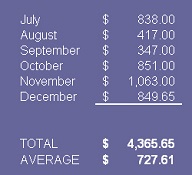
One of the largest expenditures a household faces is what they spend on food shopping. It has been for us, and we were concerned just how much we were spending and how to cut that amount down. What you think you spend on food, and what you actually do could be considerably different.
The first step to understanding what you spend, and how you can save, is to keep your receipts and sum up what you spend. Do this for three or more months to get a good picture of what you spend on food shopping. Keeping track over a three or more month time frame, and then averaging it will show what you spend on average per month. This is what we did and it helped us to see we spent a lot on food.
Just how much a family should spend at the supermarket is hard to pinpoint with precision. Are you buying just food, or also sundries and non-food items such as paper towels, pet supplies, and magazines? When these items are included in the purchases made at a food-centric store, you have to decided if the items should be separated out or just included with the total amount spent. Knowing what you spend on various items is important, but just as relevant is to stay consistent. If you wish to track just the total amounts spent at the supermarket, then do just that. Over time, the averaging of the receipts will be useful since they represent the same assortment of foods and other items.
If you are motivated to look through receipts and separate out food from non-food items, then stay consistent with that approach. This will provide two relevant summaries - food expenditures and non-food expenditures. Be aware though that this is more work. Consider that unless a large percentage of food-centric store purchases are for non-food items, just work with the receipt totals.
Decide where you food shop. Most families have a dedicated supermarket where they shop. However there may be one of more stores where you buy certain items the base supermarket does not carry. Typically these are health food items, items for special occasions, or just that some items, such as fresh produce, are better somewhere else. Don't forget the farmer's market or small shopping you might do on your lunch break at work.
Save receipts. Have an envelope or container that you can drop receipts into when you get home from the store. Sure, you can review each and any receipt when you get it, but the goal here is to first gather a sizable amount of receipts to summarize.
List the receipts - dates and total spent. Whether on paper, or in a Excel workbook or other software program - list the dates and amounts spent. Then as a month is complete, add up the amount spent in that month.
Calculate the average. The formula for calculating an average is the sum of the items divided by the number of items. This figure is from an Excel workbook.

It shows six months of food shopping expenditures, summed by month. Then the total ($4365.65) is calculated . Since this is six months of tracking, the total is divided by six, determining the average spent on food at $727.61. Here is the advantage of averaging. If one were to look at just November a conclusion could be made that this family spends over $1000 per month on food shopping. If one were to look at August, the conclusion is the family spends a bit over $400 per month. Both of these assumptions are of course way off - by hundreds of dollars.
Now that you know what your family typically spends on food on average per month, you can work on reducing this figure.
Food shopping may easily be one of your biggest expenses. But unlike your fixed expenses such as your mortgage or rent, or your car payment, food shopping spending is easy to cut down on. Just be aware of what you are spending and what you are not eating after you purchased it. It can be that simple!
Cryptocurrency is exploding! Learn about it here.
This might be for you, or not. Either way, this is inspiring and worth a look.
Why not! If you have any decent writing skills, you can be earning money from it. Check it out.